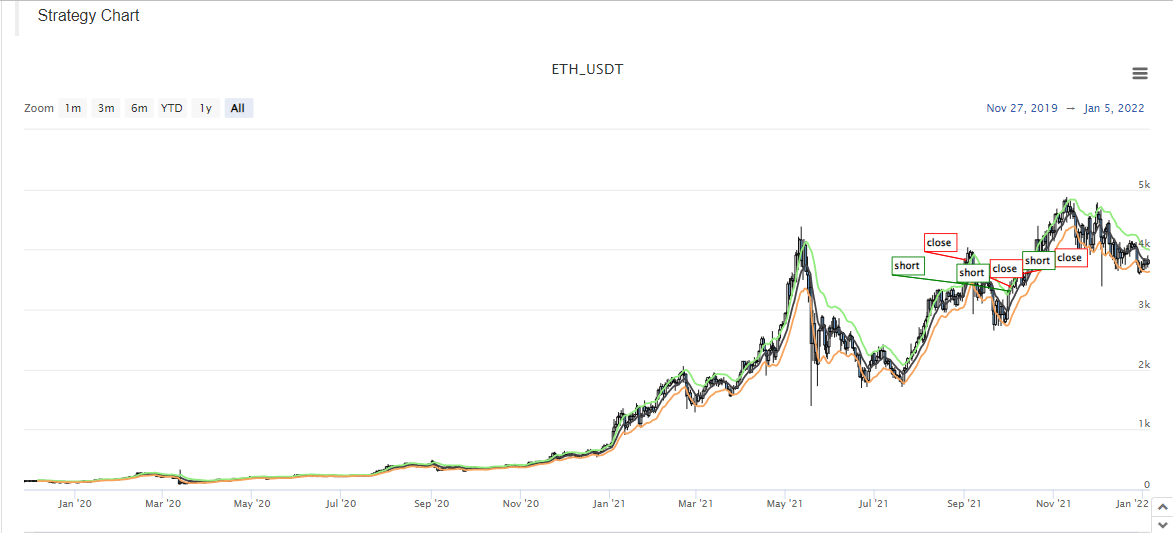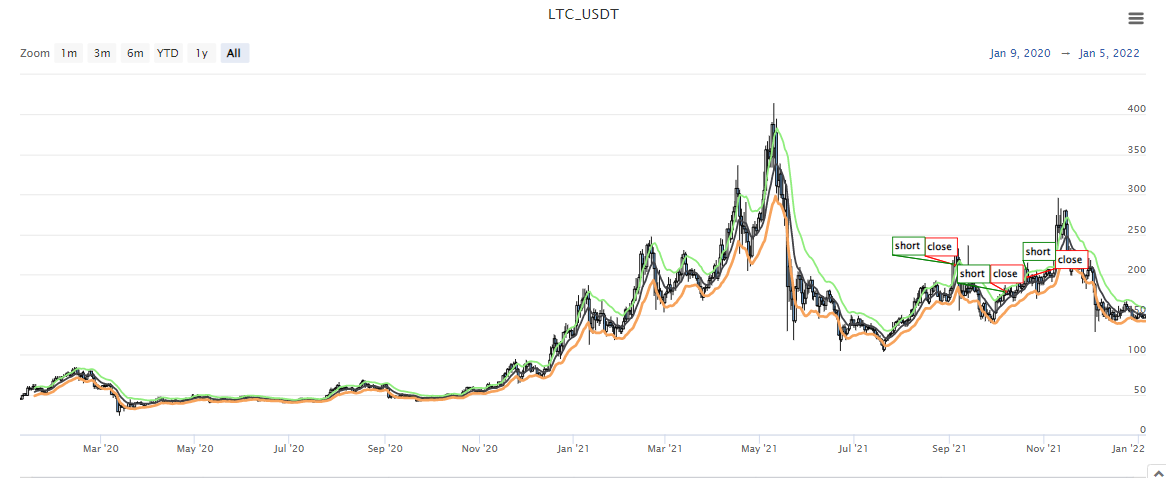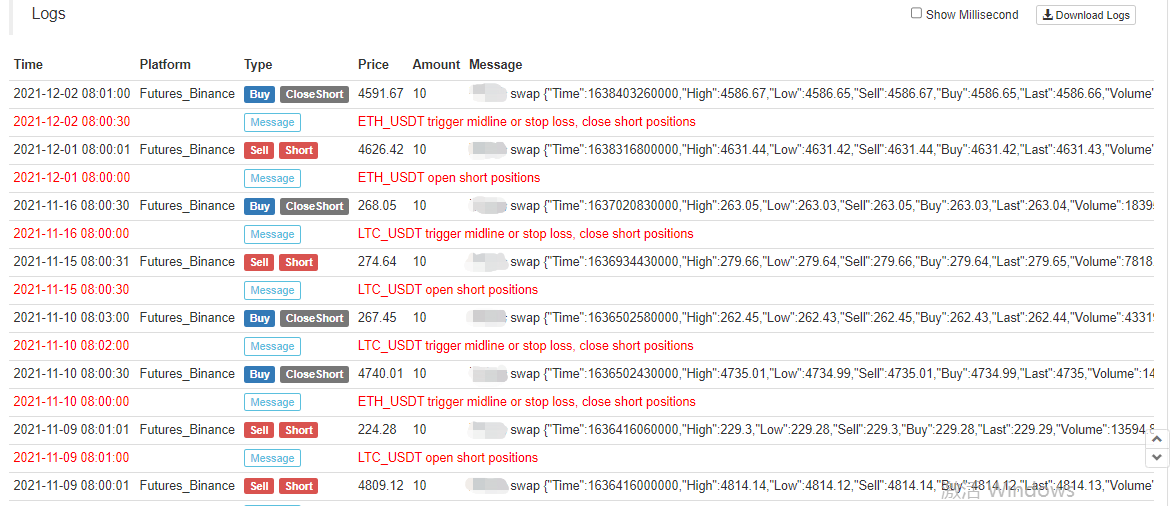ডিজিটাল মুদ্রা ফিউচার মাল্টি-স্পিসিস ATR কৌশল (টিউটোরিয়াল)
লেখক:এফএমজেড-লিডিয়া, সৃষ্টিঃ ২০২২-১১-০৮ ১০ঃ৩৪ঃ২২, আপডেটঃ ২০২৩-০৯-১৫ ২০ঃ৫৫ঃ৩৩
সাম্প্রতিককালে, আমাদের প্ল্যাটফর্মের কিছু ব্যবহারকারী একটি মাইল্যাঙ্গুয়েজ কৌশলকে একটি জাভাস্ক্রিপ্ট কৌশলতে প্রতিস্থাপনের অপেক্ষায় রয়েছেন, যা নমনীয়ভাবে অনেকগুলি অপ্টিমাইজেশন ধারণা যুক্ত করতে পারে। এমনকি কৌশলটিকে বহু-প্রজাতির সংস্করণে প্রসারিত করতে পারে। কারণ মাইল্যাঙ্গুয়েজ কৌশলটি সাধারণত একটি ট্রেন্ড কৌশল এবং তাদের মধ্যে অনেকগুলি বন্ধের মূল্য মডেলের ভিত্তিতে কার্যকর করা হয়। কৌশল অনুরোধ বিনিময়ের এপিআই ইন্টারফেস খুব ঘন ঘন নয়, যা বহু-প্রজাতির কৌশল সংস্করণে প্রতিস্থাপনের জন্য উপযুক্ত। এই নিবন্ধে, আমরা জাভাস্ক্রিপ্ট ভাষার একটি সহজ সংস্করণে প্রতিস্থাপনের জন্য একটি সহজ মাইল্যাঙ্গুয়েজ কৌশলকে উদাহরণ হিসাবে নেব। প্রধান উদ্দেশ্যটি শিক্ষণ এবং সমর্থন গবেষণা। আপনি যদি একটি বাস্তব বট তৈরি করতে চান তবে আপনাকে কিছু বিবরণ যুক্ত করতে হতে পারে (অর্ডারের পরীক্ষা মূল্য, পরিমাণের শতাংশ নির্ভুলতা, অর্ডার পরিমাণ নিয়ন্ত্রণ, সম্পদ দ্বারা অর্ডার প্রদর্শন, স্থিতি তথ্য ইত্যাদি) এবং এছাড়াও বাস্তব বট পরীক্ষার প্রয়োজন হতে পারে।
মাই ল্যাঙ্গুয়েজের কৌশল রূপান্তরিত হবে
TR:=MAX(MAX((H-L),ABS(REF(C,1)-H)),ABS(REF(C,1)-L));
ATR:=EMA(TR,LENGTH2);
MIDLINE^^EMA((H + L + C)/3,LENGTH1);
UPBAND^^MIDLINE + N*ATR;
DOWNBAND^^MIDLINE - N*ATR;
BKVOL=0 AND C>=UPBAND AND REF(C,1)<REF(UPBAND,1),BPK;
SKVOL=0 AND C<=DOWNBAND AND REF(C,1)>REF(DOWNBAND,1),SPK;
BKVOL>0 AND C<=MIDLINE,SP(BKVOL);
SKVOL>0 AND C>=MIDLINE,BP(SKVOL);
// stop loss
// stop loss
C>=SKPRICE*(1+SLOSS*0.01),BP;
C<=BKPRICE*(1-SLOSS*0.01),SP;
AUTOFILTER;
এই কৌশলটির ট্রেডিং লজিকটি সহজ। প্রথমে, পরামিতি অনুসারে ATR গণনা করুন, তারপরে সমস্ত কে-লাইন BAR এর সর্বোচ্চ, সর্বনিম্ন এবং বন্ধের দামের গড় গণনা করুন এবং তারপরে গড় ডেটা অনুসারে EMA সূচক গণনা করুন। অবশেষে, আপব্যান্ড এবং ডাউনব্যান্ড গণনা করতে পরামিতিগুলিতে ATR এবং সহগ N একত্রিত করুন।
খোলার এবং বিক্রয় পজিশনগুলি বন্ধের মূল্যে ভিত্তি করে। যখন এটি আপব্যান্ড অতিক্রম করে তখন লং পজিশন খুলুন এবং খোলার অবস্থানটি বিক্রয় করুন (যখন শর্ট পজিশন রাখা হয়) । যখন এটি ডাউনব্যান্ড অতিক্রম করে তখন শর্ট পজিশন খুলুন এবং খোলার অবস্থানটি বিক্রয় করুন। যখন বন্ধের মূল্য মধ্যরেখায় পৌঁছে যায়, তখন পজিশনটি বন্ধ হয়ে যায় এবং যখন বন্ধের মূল্য স্টপ লস মূল্যে পৌঁছে যায়, তখন পজিশনটিও বন্ধ হয়ে যায় (এসএলওএসএস অনুসারে স্টপ লস 1, অর্থাৎ 0.01, অর্থাৎ 1%) । এই কৌশলটি বন্ধের মূল্যের মডেলের মাধ্যমে কার্যকর করা হয়।
ঠিক আছে, যদি আমরা মাইল্যাঙ্গুয়েজের কৌশলগত প্রয়োজনীয়তা এবং ধারণা বুঝতে পারি, তাহলে আমরা সেগুলি প্রতিস্থাপন করতে শুরু করতে পারি।
ট্রান্সপ্ল্যান্ট এবং ডিজাইন কৌশল প্রোটোটাইপ
কৌশল প্রোটোটাইপ কোডগুলি খুব বেশি নয়, 1 থেকে 200 লাইন পর্যন্ত। কৌশল লেখার ধারণাগুলি শেখার সুবিধার্থে, মন্তব্যগুলি সরাসরি কৌশল কোডে লেখা হয়।
// parse params parameters, and parse strings as objects
var arrParam = JSON.parse(params)
// this function creates a chart configuration
function createChartConfig(symbol, atrPeriod, emaPeriod, index) { // symbol : trading pair, atrPeriod : ATR parameter period , emaPeriod : EMA parameter period, exchange object index corresponding to index
var chart = {
__isStock: true,
extension: {
layout: 'single',
height: 600,
},
title : { text : symbol},
xAxis: { type: 'datetime'},
series : [
{
type: 'candlestick', // K-line data series
name: symbol,
id: symbol + "-" + index,
data: []
}, {
type: 'line', // EMA
name: symbol + ',EMA:' + emaPeriod,
data: [],
}, {
type: 'line', // upBand
name: symbol + ',upBand' + atrPeriod,
data: []
}, {
type: 'line', // downBand
name: symbol + ',downBand' + atrPeriod,
data: []
}, {
type: 'flags',
onSeries: symbol + "-" + index,
data: [],
}
]
}
return chart
}
// main Logic
function process(e, kIndex, c) { // e is the exchange object, exchanges [0]..., kIndex is the K-line data series in the chart, and c is the chart object
// obtain K-line data
var r = e.GetRecords(e.param.period)
if (!r || r.length < e.param.atrPeriod + 2 || r.length < e.param.emaPeriod + 2) {
// if the K-line data length is insufficient, return
return
}
// calculate ATR indicators
var atr = TA.ATR(r, e.param.atrPeriod)
var arrAvgPrice = []
_.each(r, function(bar) {
arrAvgPrice.push((bar.High + bar.Low + bar.Close) / 3)
})
// calculate EMA indicators
var midLine = TA.EMA(arrAvgPrice, e.param.emaPeriod)
// calculate upBand and downBand
var upBand = []
var downBand = []
_.each(midLine, function(mid, index) {
if (index < e.param.emaPeriod - 1 || index < e.param.atrPeriod - 1) {
upBand.push(NaN)
downBand.push(NaN)
return
}
upBand.push(mid + e.param.trackRatio * atr[index])
downBand.push(mid - e.param.trackRatio * atr[index])
})
// draw the chart
for (var i = 0 ; i < r.length ; i++) {
if (r[i].Time == e.state.lastBarTime) {
// update
c.add(kIndex, [r[i].Time, r[i].Open, r[i].High, r[i].Low, r[i].Close], -1)
c.add(kIndex + 1, [r[i].Time, midLine[i]], -1)
c.add(kIndex + 2, [r[i].Time, upBand[i]], -1)
c.add(kIndex + 3, [r[i].Time, downBand[i]], -1)
} else if (r[i].Time > e.state.lastBarTime) {
// add
e.state.lastBarTime = r[i].Time
c.add(kIndex, [r[i].Time, r[i].Open, r[i].High, r[i].Low, r[i].Close])
c.add(kIndex + 1, [r[i].Time, midLine[i]])
c.add(kIndex + 2, [r[i].Time, upBand[i]])
c.add(kIndex + 3, [r[i].Time, downBand[i]])
}
}
// check the position
var pos = e.GetPosition()
if (!pos) {
return
}
var holdAmount = 0
var holdPrice = 0
if (pos.length > 1) {
throw "long and short positions are checked at the same time!"
} else if (pos.length != 0) {
holdAmount = pos[0].Type == PD_LONG ? pos[0].Amount : -pos[0].Amount
holdPrice = pos[0].Price
}
if (e.state.preBar == -1) {
e.state.preBar = r[r.length - 1].Time
}
// check the signal
if (e.state.preBar != r[r.length - 1].Time) { // closing price model
if (holdAmount <= 0 && r[r.length - 3].Close < upBand[upBand.length - 3] && r[r.length - 2].Close > upBand[upBand.length - 2]) { // the closing price cross over the upBand
if (holdAmount < 0) { // hold a short positions, close them
Log(e.GetCurrency(), "close short positions", "#FF0000")
$.CoverShort(e, e.param.symbol, Math.abs(holdAmount))
c.add(kIndex + 4, {x: r[r.length - 2].Time, color: 'red', shape: 'flag', title: 'close', text: "close short positions"})
}
// open long positions
Log(e.GetCurrency(), "open long positions", "#FF0000")
$.OpenLong(e, e.param.symbol, 10)
c.add(kIndex + 4, {x: r[r.length - 2].Time, color: 'red', shape: 'flag', title: 'long', text: "open long positions"})
} else if (holdAmount >= 0 && r[r.length - 3].Close > downBand[downBand.length - 3] && r[r.length - 2].Close < downBand[downBand.length - 2]) { // the closing price cross down the downBand
if (holdAmount > 0) { // hold long positions, close them
Log(e.GetCurrency(), "close long positions", "#FF0000")
$.CoverLong(e, e.param.symbol, Math.abs(holdAmount))
c.add(kIndex + 4, {x: r[r.length - 2].Time, color: 'green', shape: 'flag', title: 'close', text: "close long positions"})
}
// open short positions
Log(e.GetCurrency(), "open short positions", "#FF0000")
$.OpenShort(e, e.param.symbol, 10)
c.add(kIndex + 4, {x: r[r.length - 2].Time, color: 'green', shape: 'flag', title: 'short', text: "open short positions"})
} else {
// close positions
if (holdAmount > 0 && (r[r.length - 2].Close <= holdPrice * (1 - e.param.stopLoss) || r[r.length - 2].Close <= midLine[midLine.length - 2])) { // Hold a long position, the closing price is less than or equal to the midline, stop loss at the opening price
Log(e.GetCurrency(), "trigger midline or stop loss, close long positions", "#FF0000")
$.CoverLong(e, e.param.symbol, Math.abs(holdAmount))
c.add(kIndex + 4, {x: r[r.length - 2].Time, color: 'green', shape: 'flag', title: 'close', text: "close long positions"})
} else if (holdAmount < 0 && (r[r.length - 2].Close >= holdPrice * (1 + e.param.stopLoss) || r[r.length - 2].Close >= midLine[midLine.length - 2])) { // Hold a short position, the closing price is greater than or equal to the midline, stop loss at the opening price
Log(e.GetCurrency(), "trigger midline or stop loss, close short positions", "#FF0000")
$.CoverShort(e, e.param.symbol, Math.abs(holdAmount))
c.add(kIndex + 4, {x: r[r.length - 2].Time, color: 'red', shape: 'flag', title: 'close', text: "close short positions"})
}
}
e.state.preBar = r[r.length - 1].Time
}
}
function main() {
var arrChartConfig = []
if (arrParam.length != exchanges.length) {
throw "Parameters and exchange objects do not match!"
}
var arrState = _G("arrState")
_.each(exchanges, function(e, index) {
if (e.GetName() != "Futures_Binance") {
throw "The exchange is not supported!"
}
e.param = arrParam[index]
e.state = {lastBarTime: 0, symbol: e.param.symbol, currency: e.GetCurrency()}
if (arrState) {
if (arrState[index].symbol == e.param.symbol && arrState[index].currency == e.GetCurrency()) {
Log("restore:", e.state)
e.state = arrState[index]
} else {
throw "The restored data does not match the current settings!"
}
}
e.state.preBar = -1 // initial setting -1
e.SetContractType(e.param.symbol)
Log(e.GetName(), e.GetLabel(), "set contracts:", e.param.symbol)
arrChartConfig.push(createChartConfig(e.GetCurrency(), e.param.atrPeriod, e.param.emaPeriod, index))
})
var chart = Chart(arrChartConfig)
chart.reset()
while (true) {
_.each(exchanges, function(e, index) {
process(e, index + index * 4, chart)
Sleep(500)
})
}
}
function onexit() {
// record e.state
var arrState = []
_.each(exchanges, function(e) {
arrState.push(e.state)
})
Log("record:", arrState)
_G("arrState", arrState)
}
কৌশলগত পরামিতি:
var params = '[{
"symbol" : "swap", // contract code
"period" : 86400, // K-line period, 86,400 seconds is a day
"stopLoss" : 0.07, // stop loss factor, 0.07 or 7%
"atrPeriod" : 10, // ATR indicator parameters
"emaPeriod" : 10, // EMA indicator parameters
"trackRatio" : 1, // upBand and downBand coefficients
"openRatio" : 0.1 // The reserved opening percentage, which is not supported for now
}, {
"symbol" : "swap",
"period" : 86400,
"stopLoss" : 0.07,
"atrPeriod" : 10,
"emaPeriod" : 10,
"trackRatio" : 1,
"openRatio" : 0.1
}]'
ব্যাকটেস্ট স্ক্রিনশটঃ



কৌশল উৎস কোডঃhttps://www.fmz.com/strategy/339344
কৌশলগুলি শুধুমাত্র ব্যাকটেস্টিং এবং শেখার গবেষণার জন্য। অনুগ্রহ করে পরিবর্তন করুন, অপ্টিমাইজ করুন, এবং নিজের দ্বারা আসল বটটি পড়ুন।
- ক্রিপ্টোকারেন্সিতে লিড-লেগ আর্বিট্রেজের ভূমিকা (2)
- ডিজিটাল মুদ্রায় লিড-ল্যাগ স্যুটের ভূমিকা (২)
- এফএমজেড প্ল্যাটফর্মের বাহ্যিক সংকেত গ্রহণ নিয়ে আলোচনাঃ কৌশলগতভাবে অন্তর্নির্মিত এইচটিটিপি পরিষেবা সহ সংকেত গ্রহণের জন্য একটি সম্পূর্ণ সমাধান
- এফএমজেড প্ল্যাটফর্মের বহিরাগত সংকেত গ্রহণের অন্বেষণঃ কৌশলগুলি অন্তর্নির্মিত এইচটিটিপি পরিষেবাগুলির সংকেত গ্রহণের সম্পূর্ণ সমাধান
- ক্রিপ্টোকারেন্সিতে লিড-লেগ আর্বিট্রেজের ভূমিকা (1)
- ডিজিটাল মুদ্রায় লিড-ল্যাগ স্যুটের ভূমিকা
- এফএমজেড প্ল্যাটফর্মের বাহ্যিক সংকেত গ্রহণের বিষয়ে আলোচনাঃ বর্ধিত এপিআই বনাম কৌশল অন্তর্নির্মিত এইচটিটিপি পরিষেবা
- এফএমজেড প্ল্যাটফর্মের বহিরাগত সংকেত গ্রহণের অন্বেষণঃ এক্সটেনশান এপিআই বনাম কৌশল অন্তর্নির্মিত এইচটিটিপি পরিষেবা
- র্যান্ডম টিকার জেনারেটরের উপর ভিত্তি করে কৌশল পরীক্ষার পদ্ধতি নিয়ে আলোচনা
- র্যান্ডম মার্কেট জেনারেটরের উপর ভিত্তি করে কৌশলগত পরীক্ষার পদ্ধতিগুলি অনুসন্ধান করুন
- এফএমজেড কোয়ান্টের নতুন বৈশিষ্ট্যঃ সহজেই এইচটিটিপি সার্ভিস তৈরি করতে _সার্ভ ফাংশন ব্যবহার করুন
- ৫ দিনে ৮০ গুণ আয় করুন, উচ্চ-ফ্রিকোয়েন্সি কৌশল
- মেকার স্পট এবং ফিউচার হেজিং স্ট্র্যাটেজি ডিজাইনের উপর গবেষণা এবং উদাহরণ
- এসকিউএলআইটি দিয়ে এফএমজেডের একটি পরিমাণগত ডাটাবেস তৈরি করা
- কিভাবে কৌশল ভাড়া কোড মেটাডেটা মাধ্যমে একটি ভাড়া কৌশল বিভিন্ন সংস্করণ ডেটা নির্ধারণ করতে
- বিন্যান্সের সুদের মধ্যস্থতা (বর্তমান বুল মার্কেট বার্ষিক ১০০%)
- ডিজিটাল মুদ্রা ফিউচার ডাবল-ইএমএ টার্নিং পয়েন্ট কৌশল (টিউটোরিয়াল)
- ডিজিটাল মুদ্রার জন্য নতুন শেয়ার কৌশল (টিউটোরিয়াল) সাবস্ক্রাইব করুন
- ৬০ লাইন কোড দিয়ে একটি আইডিয়া বাস্তবায়ন করুন -- চুক্তির নীচে মাছ ধরার কৌশল
- ডিজিটাল মুদ্রা স্পট মাল্টি-ভেরিটি ডাবল-ইএমএ কৌশল (টিউটোরিয়াল)
- এফএমজেড কোয়ান্টের উপর ভিত্তি করে অর্ডার সিঙ্ক্রোনাইজেশন ম্যানেজমেন্ট সিস্টেমের নকশা (2)
- পাইন ভাষা ব্যবহার করে একটি অর্ধ স্বয়ংক্রিয় ট্রেডিং টুল লিখুন
- লিক্স রিপার এর ম্যাজিক পরিবর্তন থেকে উচ্চ ফ্রিকোয়েন্সি কৌশল নকশা অন্বেষণ করুন
- লিজ রিপার কৌশল বিশ্লেষণ (2)
- ইউটিউব ভেটেরান্সের "ম্যাজিক ডাবল ইএমএ স্ট্র্যাটেজি"
- ফিশার সূচক এবং এফএমজেডের উপর অঙ্কনের জাভাস্ক্রিপ্ট ভাষা বাস্তবায়ন
- dYdX কৌশল নকশা উদাহরণ
- এফএমজেড কোয়ান্টের উপর ভিত্তি করে অর্ডার সিঙ্ক্রোনাইজেশন ম্যানেজমেন্ট সিস্টেমের নকশা (1)
- লিক্স রিপার কৌশল বিশ্লেষণ (১)
- ডেরিবিট অপশন ডেল্টা ডায়নামিক হেজিং কৌশল
- তহবিলের হার কৌশল সাম্প্রতিক অবস্থা এবং প্রস্তাবিত অপারেশন